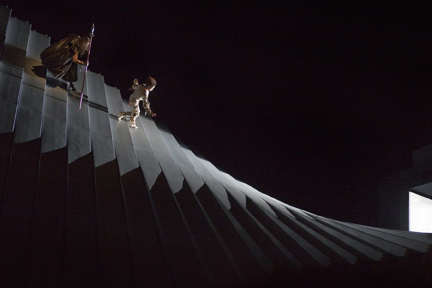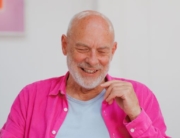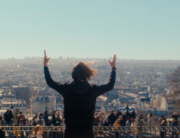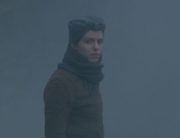
A scene from Robert Lepage’s DAS RHEINGOLD (Ken Howard)
![]() During its final days, the Tribeca Film Festival world premiered three New York-centric fine arts documentaries. The most penetrating of the trio, Wagner’s Dream is an engrossing look behind the curtain of the Metropolitan Opera, and is the perhaps best film about that art form, fictional or otherwise, though it may have that field all to itself. Saturated with excerpts from the sumptuous score of Richard Wagner’s “Ring des Nibelungen,” it will wear down any resistance to the composer or to sitting through his four-part, 16-hour-long saga of gods and greed.
During its final days, the Tribeca Film Festival world premiered three New York-centric fine arts documentaries. The most penetrating of the trio, Wagner’s Dream is an engrossing look behind the curtain of the Metropolitan Opera, and is the perhaps best film about that art form, fictional or otherwise, though it may have that field all to itself. Saturated with excerpts from the sumptuous score of Richard Wagner’s “Ring des Nibelungen,” it will wear down any resistance to the composer or to sitting through his four-part, 16-hour-long saga of gods and greed.
In the process, the Met has received something in exchange for opening its backstage to director Susan Froemke. Her film’s an effective promotional piece for the venerable company—you see how the sausage is made, so to speak—and it offers more than enough opportunities for general manager Peter Gelb and stage director Robert Lepage to staunchly defend their new technically complicated, $16 million production, which has received mostly spotty reviews. Yet the company deserves credit for allowing Froemke to air some of the criticism heaped on the hyped production and to film its mishaps, both technical and man-made.
The film succeeds in making even an opera novice care about whether the new production succeeds with audiences or if it will help bring in a new and younger demographic to the house. The backbone of Lepage’s “Ring” Cycle rests on a 45-ton apparatus, dubbed the “machine,” made up of 24 side-by-side planks revolving from an axis, upon which are projected video imagery triggered by the singers’ movements and vocal interactions. The aluminum-and-fiberglass planks move every which way (sometimes with a thud or two), shifting the setting from the bottom of the Rhine to the mountaintop playground of the gods.
After a dry first half-hour, the film takes flight, moving from the machine’s technical testing ground in Quebec to the Met, where the singers square off against their computer-run stage partner. Among the singers, Froemke judiciously zooms in on soprano Deborah Voigt as her main focus. It’s the first time Voigt has ever sang the vocally challenging lead role of the warrior goddess-turned-mortal Brünnehilde, and she’s completely upfront before the camera. Of all of the cast members, Voigt faces the most physical obstacles on the steeply raked set. Unfortunately, some of the best singers/actors today are not seen at all, tenor Jonas Kaufmann, as Siegmund, among them.
“Ring” first-timers will get the gist of the densely layered saga. Perhaps intentionally avoiding a can of worms, the film stays away from mentioning the incestuous union between twins Siegmund and Sieglinda, or from recounting Wagner’s biography and his controversial historical legacy—material enough for another film (or two).
The harshest criticism about Lepage’s “Ring” has been lobbied by The New Yorker’s Alex Ross, who has describe it as “Pound for pound, ton for ton, the most witless and wasteful production in modern operatic history.” (I’ve seen all four parts as they debuted, and that’s way too harsh an assessment.) During the orchestral preludes, the machine is the razzle-dazzle star, and the production design is quite beautiful, especially the ominous forest at the top of Die Walküre and scenes with the agile Rhinemaidens. However, Fafner the dragon in Siegfried and the end-of-the-world climax in Götterdämmerung felt threadbare and thrown together. For all of the technical, state-of the-art innovations, the overall production is quite tame compared to Francesca Zambello’s Americana “Ring” for San Francisco Opera last year, in which Siegfried was set in a post-apocalyptic 1950s wasteland.
But tellingly, nowhere in Dream will you find a rehearsal between the director and his singers/actors. Often it seemed as though they were just told where to stand. What the film can’t capture are the long stretches within the operas where the singers seemed trapped between the machine and the lip of the stage. (Since the premieres, blocking has been altered). That said, Siegfried featured Voigt’s best acting, and no one could ask for a better Albrecht (Eric Owens) or Fricka (Stephanie Blythe).
Commemorating the oldest American performing arts center’s sesquicentennial anniversary, BAM150 takes a slightly different approach than Wagner’s Dream. It’s more of a tribute than a dissection of the Brooklyn Academy of Music, which in Michael Sládek’s documentary stands in for the entire borough. Originally situated in Brooklyn Heights, it was a challenge to neighboring Manhattan’s cultural dominance. Edwin Booth, Eleonora Duse, Sarah Bernhardt, Mark Twain, Caruso—all have appeared on its stage. In its current Fort Greene neighborhood, BAM fell into hard, crime-ridden times and was almost razed in the 1960s, but the programming of its former executive director, Harvey Lichtenstein, saved it. He offered an alternative to what could be found in Manhattan: the free love manifesto of the Living Theatre (Lichtenstein promised the cops that no one would leave the theater nude), Robert Wilson, Steve Reich, and a who’s who of the cutting edge in theater. Appropriately for a film that’s an ideal fund raising tool, BAM’s Executive Producer Joseph V. Melillo and President Karen Brooks Hopkins are co-producers.
Fortunately, the Tribeca screening of the affectionate and frank Joe Papp in Five Acts isn’t the only opportunity to see Tracie Holder and Karen Thorsen’s thoughtful portrait of the founder of Shakespeare in the Park (still free to the public after 50 years) and the Public Theater. Because of the tight 90-minute format, the filmmakers pack in a lot, offering a big picture and leaving it to biographies to fill in the details. For example, Meryl Streep describes the theater producer’s behavior as “brutal” and Roscoe Lee Brown calls him a “minor Fascist”—leaving you craving for more dirt. It will air on PBS’s American Masters series in 2013 (so you have to be patient).






Leave A Comment